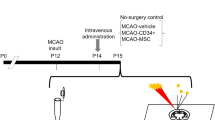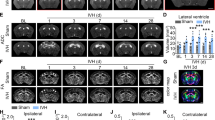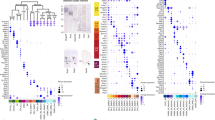Abstract
Tissue inhibitor of metalloproteinase-3 (TIMP-3) is a natural inhibitor of metalloproteinases involved in matrix degradation and ectodomain shedding of many cell-surface proteins, including death receptors and/or their ligands. In the present study, we examined the role of TIMP-3 in Fas-mediated neuronal cell death following cerebral ischemia, using both gene deletion and pharmacological approaches. In culture, exposure of primary cortical neurons to 2 h of oxygen–glucose deprivation (OGD) resulted in delayed neuronal cell death that was dependent on activation of the death receptor, Fas. Cortical cultures derived from timp-3−/− mice displayed partial resistance against OGD-induced neuronal cell death and also displayed increased shedding of Fas ligand (FasL) into the culture media, compared to wild-type control cultures. Both the increased neuroprotection and increased FasL shedding in timp-3−/− cultures were reversed by addition of exogenous metalloproteinase inhibitors, recombinant TIMP-3 or GM6001. In vivo, timp-3−/− mice showed marked resistance to a brief (30 min) middle cerebral artery occlusion (MCAO), but were not protected against more severe lesions induced by 90 min of MCAO. These studies demonstrate that TIMP-3 facilitates Fas-mediated neuronal cell death following OGD and plays a pro-apoptotic role in mild cerebral ischemia.
Similar content being viewed by others
Log in or create a free account to read this content
Gain free access to this article, as well as selected content from this journal and more on nature.com
or
Abbreviations
- rTIMP-3:
-
recombinant tissue inhibitor of metalloproteinases-3
- OGD:
-
oxygen–glucose deprivation
- MCAO:
-
middle cerebral artery occlusion
- TNFR:
-
tumor necrosis factor receptor
References
Ashkenazi A, Dixit VM . Death receptors: signaling and modulation. Science 1998; 281: 1305–1308.
Qiu J, Whalen MJ, Lowenstein P, Fiskum G, Fahy B, Darwish R et al. Upregulation of the Fas receptor death-inducing signaling complex after traumatic brain injury in mice and humans. J Neurosci 2002; 22: 3504–3511.
Ethell DW, Buhler LA . Fas ligand-mediated apoptosis in degenerative disorders of the brain. J Clin Immunol 2003; 23: 439–446.
Hovelmeyer N, Hao Z, Kranidioti K, Kassiotis G, Buch T, Frommer F et al. Apoptosis of oligodendrocytes via Fas and TNF-R1 is a key event in the induction of experimental autoimmune encephalomyelitis. J Immunol 2005; 175: 5875–5884.
Martin-Villalba A, Hahne M, Kleber S, Vogel J, Falk W, Schenkel J et al. Therapeutic neutralization of CD95-ligand and TNF attenuates brain damage in stroke. Cell Death Differ 2001; 8: 679–686.
Felderhoff-Mueser U, Taylor DL, Greenwood K, Kozma M, Stibenz D, Joashi UC et al. Fas/CD95/APO-1 can function as a death receptor for neuronal cells in vitro and in vivo and is upregulated following cerebral hypoxic–ischemic injury to the developing rat brain. Brain Pathol 2000; 10: 17–29.
Rosenbaum DM, Gupta G, D'Amore J, Singh M, Weidenheim K, Zhang H et al. Fas (CD95/APO-1) plays a role in the pathophysiology of focal cerebral ischemia. J Neurosci Res 2000; 61: 686–692.
Yew DT, Ping Li W, Liu WK . Fas and activated caspase 8 in normal, Alzheimer and multiple infarct brains. Neurosci Lett 2004; 367: 113–117.
Wallace JA, Alexander S, Estrada EY, Hines C, Cunningham LA, Rosenberg GA . Tissue inhibitor of metalloproteinase-3 is associated with neuronal death in reperfusion injury. J Cereb Blood Flow Metab 2002; 22: 1303–1310.
Kuan CY, Whitmarsh AJ, Yang DD, Liao G, Schloemer AJ, Dong C et al. A critical role of neural-specific JNK for ischemic apoptosis. Proc Natl Acad Sci USA 2003; 100: 15184–15189.
Blankenberg FG, Kalinyak J, Liu L, Koike M, Cheng D, Goris ML et al. 99mTc-HYNIC-annexin V SPECT imaging of acute stroke and its response to neuroprotective therapy with anti-Fas ligand antibody. Eur J Nucl Med Mol Imaging 2006; 33: 566–574.
French LE, Tschopp J . Protein-based therapeutic approaches targeting death receptors. Cell Death Differ 2003; 10: 117–123.
Beier CP, Wischhusen J, Gleichmann M, Gerhardt E, Pekanovic A, Krueger A et al. FasL (CD95L/APO-1L) resistance of neurons mediated by phosphatidylinositol 3-kinase-Akt/protein kinase B-dependent expression of lifeguard/neuronal membrane protein 35. J Neurosci 2005; 25: 6765–6774.
Mitsiades N, Yu WH, Poulaki V, Tsokos M, Stamenkovic I . Matrix metalloproteinase-7-mediated cleavage of Fas ligand protects tumor cells from chemotherapeutic drug cytotoxicity. Cancer Res 2001; 61: 577–581.
Kheradmand F, Werb Z . Shedding light on sheddases: role in growth and development. BioEssays 2002; 24: 8–12.
Powell WC, Fingleton B, Wilson CL, Boothby M, Matrisian LM . The metalloproteinase matrilysin proteolytically generates active soluble Fas ligand and potentiates epithelial cell apoptosis. Curr Biol 1999; 9: 1441–1447.
Tanaka M, Itai T, Adachi M, Nagata S . Downregulation of Fas ligand by shedding. Nat Med 1998; 4: 31–36.
Woessner Jr JF . That impish TIMP: the tissue inhibitor of metalloproteinases-3. J Clin Invest 2001; 108: 799–800.
Leco KJ, Khokha R, Pavloff N, Hawkes SP, Edwards DR . Tissue inhibitor of metalloproteinases-3 (TIMP-3) is an extracellular matrix-associated protein with a distinctive pattern of expression in mouse cells and tissues. J Biol Chem 1994; 269: 9352–9360.
Ahonen M, Poukkula M, Baker AH, Kashiwagi M, Nagase H, Eriksson JE et al. Tissue inhibitor of metalloproteinases-3 induces apoptosis in melanoma cells by stabilization of death receptors. Oncogene 2003; 22: 2121–2134.
Baker AH, George SJ, Zaltsman AB, Murphy G, Newby AC . Inhibition of invasion and induction of apoptotic cell death of cancer cell lines by overexpression of TIMP-3. Br J Cancer 1999; 79: 1347–1355.
Bond M, Murphy G, Bennett MR, Newby AC, Baker AH . Tissue inhibitor of metalloproteinase-3 induces a Fas-associated death domain-dependent type II apoptotic pathway. J Biol Chem 2002; 277: 13787–13795.
Smith MR, Kung H, Durum SK, Colburn NH, Sun Y . TIMP-3 induces cell death by stabilizing TNF-alpha receptors on the surface of human colon carcinoma cells. Cytokine 1997; 9: 770–780.
Mitsiades N, Poulaki V, Leone A, Tsokos M . Fas-mediated apoptosis in Ewing's sarcoma cell lines by metalloproteinase inhibitors. J Natl Cancer Inst 1999; 91: 1678–1684.
Wetzel M, Rosenberg GA, Cunningham LA . Tissue inhibitor of metalloproteinases-3 and matrix metalloproteinase-3 regulate neuronal sensitivity to doxorubicin-induced apoptosis. Eur J Neurosci 2003; 18: 1050–1060.
Jaworski DM, Fager N . Regulation of tissue inhibitor of metalloproteinase-3 (Timp-3) mRNA expression during rat CNS development. J Neurosci Res 2000; 61: 396–408.
Wetzel M, Tibbitts J, Rosenberg GA, Cunningham LA . Vulnerability of mouse cortical neurons to doxorubicin-induced apoptosis is strain-dependent and is correlated with mRNAs encoding Fas, Fas-Ligand, and metalloproteinases. Apoptosis 2004; 9: 649–656.
Le DA, Wu Y, Huang Z, Matsushita K, Plesnila N, Augustinack JC et al. Caspase activation and neuroprotection in caspase-3-deficient mice after in vivo cerebral ischemia and in vitro oxygen glucose deprivation. Proc Natl Acad Sci USA 2002; 99: 15188–15193.
Martin-Villalba A, Herr I, Jeremias I, Hahne M, Brandt R, Vogel J et al. CD95 ligand (Fas-L/APO-1L) and tumor necrosis factor-related apoptosis-inducing ligand mediate ischemia-induced apoptosis in neurons. J Neurosci 1999; 19: 3809–3817.
Endres M, Namura S, Shimizu-Sasamata M, Waeber C, Zhang L, Gomez-Isla T et al. Attenuation of delayed neuronal death after mild focal ischemia in mice by inhibition of the caspase family. J Cereb Blood Flow Metab 1998; 18: 238–247.
Finan KM, Hodge G, Reynolds AM, Hodge S, Holmes MD, Baker AH et al. In vitro susceptibility to the pro-apoptotic effects of TIMP-3 gene delivery translates to greater in vivo efficacy versus gene delivery for TIMPs-1 or -2. Lung Cancer 2006; 53: 273–284.
Bond M, Murphy G, Bennett MR, Amour A, Knauper V, Newby AC et al. Localization of the death domain of tissue inhibitor of metalloproteinase-3 to the N terminus. Metalloproteinase inhibition is associated with proapoptotic activity. J Biol Chem 2000; 275: 41358–41363.
Matsuno H, Yudoh K, Watanabe Y, Nakazawa F, Aono H, Kimura T . Stromelysin-1 (MMP-3) in synovial fluid of patients with rheumatoid arthritis has potential to cleave membrane bound Fas ligand. J Rheumatol 2001; 28: 22–28.
Georgopoulos S, Plows D, Kollias G . Transmembrane TNF is sufficient to induce localized tissue toxicity and chronic inflammatory arthritis in transgenic mice. J Inflamm 1996; 46: 86–97.
Kassiri Z, Oudit GY, Sanchez O, Dawood F, Mohammed FF, Nuttall RK et al. Combination of tumor necrosis factor-alpha ablation and matrix metalloproteinase inhibition prevents heart failure after pressure overload in tissue inhibitor of metalloproteinase-3 knock-out mice. Circ Res 2005; 97: 380–390.
Mohammed FF, Smookler DS, Taylor SE, Fingleton B, Kassiri Z, Sanchez OH et al. Abnormal TNF activity in Timp3−/− mice leads to chronic hepatic inflammation and failure of liver regeneration. Nat Genet 2004; 36: 969–977.
Smookler DS, Mohammed FF, Kassiri Z, Duncan GS, Mak TW, Khokha R . Cutting edge: tissue inhibitor of metalloproteinase 3 regulates TNF-dependent systemic inflammation. J Immunol 2006; 176: 721–725.
Pradillo JM, Romera C, Hurtado O, Cardenas A, Moro MA, Leza JC et al. TNFR1 upregulation mediates tolerance after brain ischemic preconditioning. J Cereb Blood Flow Metab 2005; 25: 193–203.
Cunningham LA, Wetzel M, Rosenberg GA . Multiple roles for MMPs and TIMPs in cerebral ischemia. Glia 2005; 50: 329–339.
Leco KJ, Waterhouse P, Sanchez OH, Gowing KL, Poole AR, Wakeham A et al. Spontaneous air space enlargement in the lungs of mice lacking tissue inhibitor of metalloproteinases-3 (TIMP-3). J Clin Invest 2001; 108: 817–829.
Acknowledgements
This work was supported by NIH R01 NS04737 (LAC).
Author information
Authors and Affiliations
Corresponding author
Additional information
Edited by L Greene
Rights and permissions
About this article
Cite this article
Wetzel, M., Li, L., Harms, K. et al. Tissue inhibitor of metalloproteinases-3 facilitates Fas-mediated neuronal cell death following mild ischemia. Cell Death Differ 15, 143–151 (2008). https://doi.org/10.1038/sj.cdd.4402246
Received:
Revised:
Accepted:
Published:
Issue date:
DOI: https://doi.org/10.1038/sj.cdd.4402246
Keywords
This article is cited by
-
IGF1R+ Dental Pulp Stem Cells Enhanced Neuroplasticity in Hypoxia-Ischemia Model
Molecular Neurobiology (2017)
-
Role of IGF1R+ MSCs in modulating neuroplasticity via CXCR4 cross-interaction
Scientific Reports (2016)
-
SUMO-specific protease 1 protects neurons from apoptotic death during transient brain ischemia/reperfusion
Cell Death & Disease (2016)
-
Effect of Ermiao Recipe (二妙方) with medicinal guide Angelicae Pubescentis Radix on promoting the homing of bone marrow stem cells to treat cartilage damage in osteoarthritis rats
Chinese Journal of Integrative Medicine (2014)
-
Adaptive Changes in the Neuronal Proteome: Mitochondrial Energy Production, Endoplasmic Reticulum Stress, and Ribosomal Dysfunction in the Cellular Response to Metabolic Stress
Journal of Cerebral Blood Flow & Metabolism (2013)



